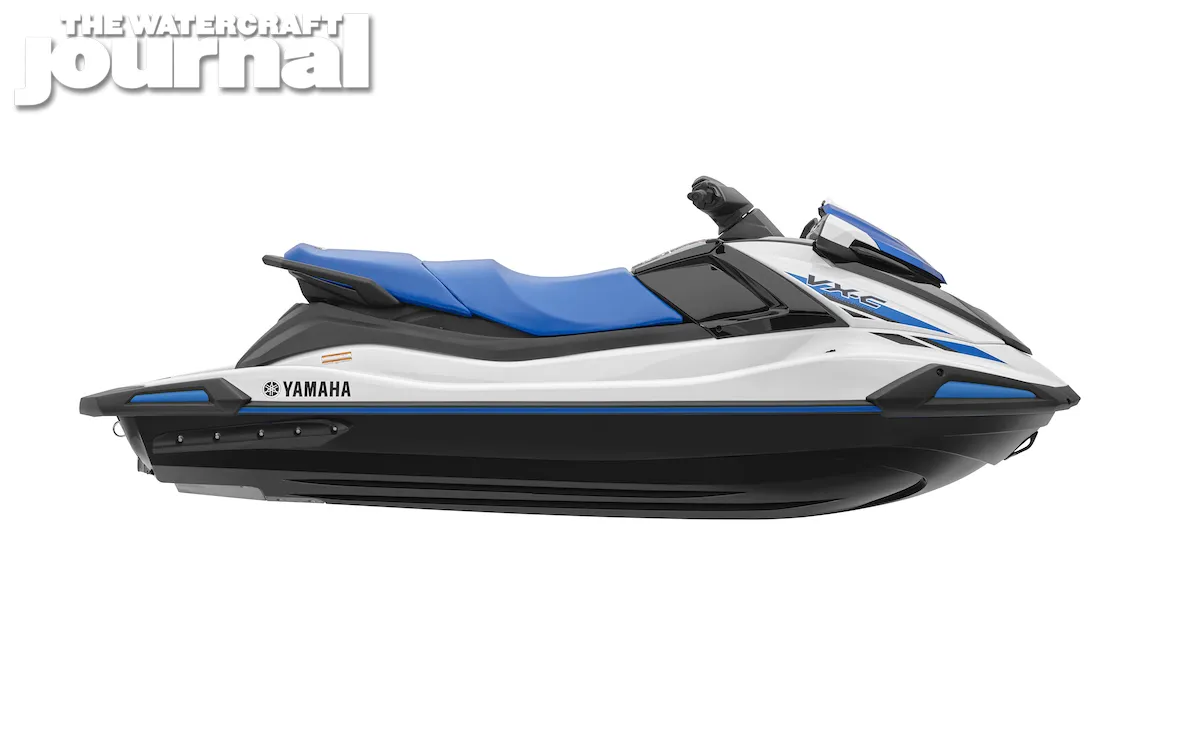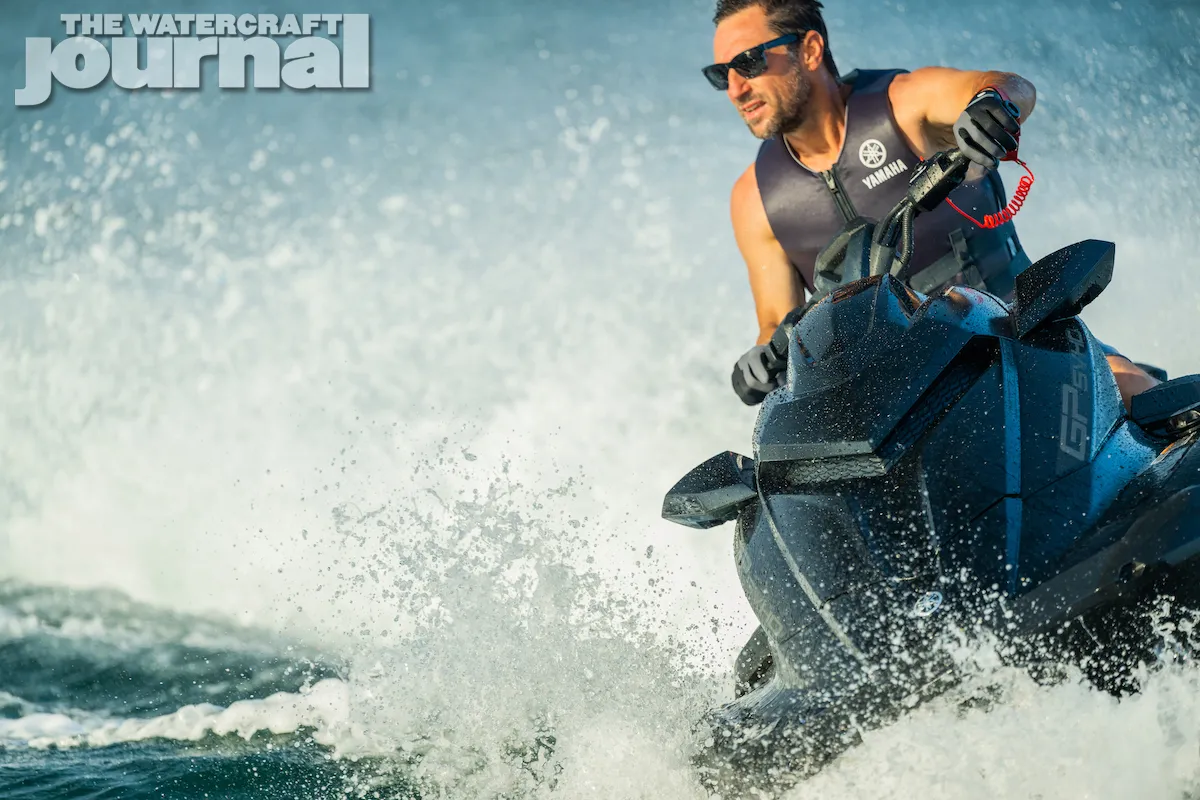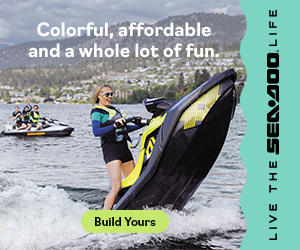If you think 2024 marks another year of just “bold new graphics” for Yamaha Motor Corp. USA you’re not paying attention. Despite Yamaha’s cache of 20 WaveRunners appearing mainly unchanged, this coming model year heralds a great many upgrades and innovations made by the manufacturer, some of which brings Yamaha closer to fulfilling its public commitment to becoming 100% carbon neutral by 2035.
Intriguing (and frankly, groundbreaking) plant-based, recyclable materials (more on that later); lead-free rod and main bearings; and a near-complete “blank sheet” redesign of its naturally-aspirated marine engine – for optimal fuel efficiency and reduced CO2 emissions – all indicate the direction that Yamaha is going towards.
This new 4-stroke also re-establishes Yamaha as the leader of engine displacement: a 1,898cc (1.9L) four-cylinder, 16-valve High Output marine engine – producing 200-horsepower – replaces the previous 180-horsepower Yamaha 1.8L High Output motor in all VX, GP and FX previously equipped with such.
All WaveRunners equipped with the new 1.9L receive a new overlapping impeller and redesigned intake grate for better hookup and acceleration – be it VX, GP or FX. This “top loader” design features a deeper chip for increased bite and a more aggressive scoop grate to force more water faster into the 155mm axial jet pump.
Interestingly, Yamaha rebranded the entire GP series: rechristening the GP1800R SVHO the GP SVHO, and GP1800R HO the GP HO. The GP HO also picks up features previously found only on prior SVHO skis; namely, auto trim and launch control, which is a nod at the GP HO’s potential – reaching a maximum speed of 63mph (more on that in a bit).
Other HO-equipped WaveRunners received attention as well. Yamaha caved to consumer outcry and replaced all 5-inch screens on the FX HO models with the larger 7-inch Connext touchscreen, previously only available on the SVHO models. Equally, all FX units enjoy the addition of new Drive Control options like Economy, Towing, Performance, Comfort and Custom settings.
On the flip side, Yamaha has not addressed the vexing mileage counter software that zeros out trip mileage and miles-to-empty when the ignition is killed. Despite this infuriating enthusiasts, Yamaha has stated privately that it is aware of the issue and has no plans to “patch” the current software, implying a fix will arrive with a future version of Connext …someday.
Lastly, Yamaha upped its coloration in a big way. Besides the lowly SuperJet, which remains in its “blank slate” white livery; all other models are splashed in vibrant hues and busy graphics meant to catch the eye and draw attention. Even the Parts & Accessories group gets in the action by offering three CNC-mat colorations for the RecDeck (and attachments) as a choice of black or white housing for the floating detachable EX speakers.
For more on the redesigned 1,898cc HO engine, The Watercraft Journal spoke with Greg Gaddis of Greenhulk Garage who was the solitary media outlet invited to review the new engine – even going so far as partially disassembling the new motor – and managing to ride the GP HO and FX HO WaveRunners prior to its public reveal.
Gaddis explained, “[The] 1.9L engine looks very familiar to the outgoing 1.8L but hosts [several] changes to make it better, more powerful, and environmentally friendly. The main goal of the redesign is efficiency and lessening the environmental impact from production and operating. […] This engine is almost all new, meaning there are few components that will be carrying over to the new platform.
“The crankshaft, connecting rods, oil pan, pickup, oil pump, oil cooler, and PTO cover are the only components carrying over to the new engine; being that the connecting rods and crankshaft are carryover parts, Yamaha increased displacement by changing to 88 millimeter pistons (2 millimeters larger) that feature a flatter, more shallow dome which increase compression to 11.2:1 over the previous 11:1 ratio.
“Oddly enough, the 1.9L oil capacity is one quart less than the outgoing 1.8L. Both engines use the same oil pan so less oil has me puzzled; my assumption is that one quart less oil per watercraft (with thousands of units produced) is substantially lessening the environmental impact for production.
“Yamaha [is also] transitioning to lead free rod bearings and main bearings for environmental reasons. […] Lead is a natural lubricant and damper but highly toxic. Lead free bearings are environmentally safer and are more resistant to corrosion.
“The 1.9L has an all new block and cylinder head casting. Drastic changes were made to the casting for revised water jacketing and coolant passages with the intent to keep the cylinder head cool while keeping block and oil temperatures higher, […] the thermostat housing is now in the block instead of the cylinder head.”
“The rectifier is now getting cooling from the cylinder head rather than the exhaust manifold to lower the overall temperatures, as today’s more advanced electronics demand more power. One of the last major coolant changes was between the exhaust and intake ports on each cylinder. Additional cooling between the ports will further lower cylinder head temperatures and increase efficiency.
“The cylinder head features redesigned intake ports, exhaust ports, and combustion chambers. The intake ports were opened up to elongated ovals […] to flow more air into the combustion chamber. The exhaust ports were shrunk two millimeters [for better] exhaust scavenging. The combustion chambers were also opened up.
“With the addition to the new intake and exhaust ports, Yamaha had to redesign both intake and exhaust manifolds to accommodate for the new cylinder head design. The new intake manifold features a larger plenum, longer runners, 10 percent larger throttle body, and a larger flame arrestor. The throttle body is [now] 65 millimeters.
“The previous engine had a 60mm, and the flame arrestor [was] changed from a 68mm to an 88mm.” Per a recent communication from YMC confirms that “the ribbon is fully captured in the new manifold, making it essentially impossible for it to dislodge.”
“Not only is the plenum larger, but the overall shape has been revised from the basic, log style manifold. The new intake manifold integrates the manifold air pressure sensor and intake air temp sensor into one, simplifying the wire harness; the outgoing manifold had two separate sensors for MAP and IAT.
“The exhaust manifold has been narrowed and optimized for performance; runners two and three now resemble a “two-to-one” [flange] which further increases the exhaust scavenging and allows for the narrower design. Both intake and exhaust manifolds use fewer bolts and are positioned closer to the block. The slimmer design allows for more room around the engine, [easier] access to engine sensors and the sacrificial anode for servicing.
“The new block casting is equipped with a supercharger block off plate hinting at a supercharged SVHO variant in the future. The second change is a bolt going through the center of the front side of the cylinder head. This area of the cylinder head has an internal void for the timing chain which creates noise and vibration. The purpose of the bolt is to secure the front section of the cylinder head casting to reduce the noise and vibration.
Gaddis did voice disappointment that all of Yamaha’s changes resulted in a meager 20-horsepower gain, stating, “I would expect a higher horsepower gain from almost 100 more cubic centimeters, a better flowing [cylinder head, intake manifold, throttle body and exhaust manifold], and a more efficient cooling system. I believe this is due to a change that Yamaha has made to the new camshafts.
“Yamaha has made a significant change to the camshaft design [as it aimed for] a smoother idle and operation throughout the entire powerband.. While the duration and lift remain the same, the cams now have less lobe separation angle. Less lobe separation angle means more overlap and more midrange torque. Being that the new engine flows more air and has a higher compression ratio than the outgoing 1.8L, the new engine can take advantage of more overlap. Yamaha increased the intake cam overlap from 36 to 39 degrees.
“I firmly believe that this change in overlap is resulting in a smaller power increase compared to what the engine revision could have produced.” Gaddis concluded. “Aside from the change in overlap, Yamaha redesigned the camshaft caps. Yamaha moved to a simpler design; there are now four camshaft caps compared to six and the caps are slimmer. The slimmer camshaft caps resulted in a new valve cover that is sleeker, part of Yamaha’s intent for a more serviceable engine.
“Yamaha’s desire for a smoother operation led to a more revised rev limiter. Yamaha changed to a high detection resolution for revolution on the rotor. This means a more refined and controlled rev limiter. This new rotor design prevents the common “banging” off of the rev limiter and offers a smoother experience when coming unhooked in rough water.” During a private test session, Gaddis recorded slightly over 62mph aboard both the GP HO and FX HO using redundant GPS trackers.
“Obviously, these changes were made with the intent of efficiency and not for all-out performance. Yamaha seems to be making a push for more efficient engines, more efficient production, and a greener environmental footprint. This is quite obvious with Yamaha’s material choice for bearings and the new plant-infused engine cover. Yes, I said a plant infused engine cover…”
Officially, Yamaha announced: “The engine cover is also one of the first Yamaha-manufactured parts to include plant-derived cellulose nano fiber (CNF) reinforced resin. In addition to being more than 25-percent lighter than existing resin materials, CNF-reinforced resin also has excellent material recyclability, leading to a reduction in plastics used and greenhouse gas emissions, mainly carbon dioxide.”
We at The Watercraft Journal fully expect Yamaha’s CNF resin to appear in future parts and components, including replacing existing plastic fairings, panels and possibly in a future date, even hulls. Great expense was made to develop this technology and you can bet it won’t be used exclusively on a lowly engine cover.
Lastly, we come to pricing. To be expected, MSRP list prices have increased across the board, but some more than others. Beginning by segment, every Rec Lite unit is up $200: EX: $7,799, EX Sport: $9,099, EX Deluxe: $10,199 and EX Limited: $10,799. For the VX segment, it goes VX-C: $10,199 (up $200), VX: $11,399 (up $200), VX Deluxe: $12,399 (up $300), VX Cruiser: $12,799 (up $300), VX Cruiser HO: $13,599 (up $300), VX Limited: $13,999 (up $300) and VX Limited HO: $15,299 (up $300).
For the GP series both entries increase by $300 each, namely the newly minted GP HO: $14,499 and the GP SVHO: $16,799. For the Freestyle segment, both entries are up by $200 each, including SuperJet: $10,699 and JetBlaster: $10,899. Finally, for the Luxury segment, the FX HO: $15,699 (up $200), FX Cruiser HO: $16,999 (up $300), FX SVHO: $19,299 (up $300), FX Cruiser SVHO: $19,799 (up $400) and FX Limited SVHO: $20,399 (up $400).
In all, it looks like Yamaha is committed toward a cleaner, more sustainable future through producing more efficient engines through less environmentally-impactful processes, and featuring new recyclable materials. Whether customers will be drawn to Yamaha because of this remains to be seen; but what isn’t in question is the attention the new lineup is getting. Contact your dealer for more information or visit www.yamahawaverunners.com.


































































































































































